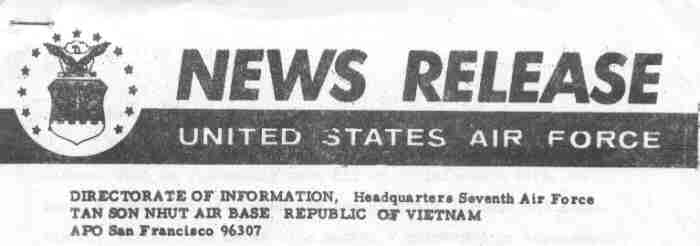|
Official News Release of incident of 11 March, 1968
An exact copy of the Official News Release on Brew 41

FOR IMMEDIATE RELEASE
7-68-175
PILOT EARNS SILVER STAR By: TSgt. Johnnie C. Fletcher
FOR HEROIC VIETNAM FLIGHT
NHA TRANG (7AF) -- Flying a damaged C-47 Skytrain over 100 miles of enemy
infested territory and successfully landing the crippled plane on short runway
without flaps or brakes and with a blown tire has earned Lieutenant Colonel Robert
E. Dobyns, 45, Sacramento, Calif., the Silver Star.
He received the award recently from Brigadier General Robert J. Holbury,
commander, 460th Tactical Reconnaissance Wing, in ceremonies at the 361st Tactical
Electronics Warfare Squadron at Nha Trang Air Base.
Crew members on the heroic flight who were awarded the Distinguished Flying
Cross were Second Lieutenant Stanley R. Marks II, 24, Corpus Christi, Tex., the pilot
Major John J. Polites, 45, Merced, Calif., navigator, Staff Sergeant David J. Lott,
27, Newark, Ohio, flight engineer, and Staff Sergeants Louis R. Stennes, 24, Fort
Plain, N.Y., and Kenneth J. Corbin, 26, Berlin, N.Y., radio operators.
As Dobyns described the mission:
"We had been flying over our mission area about 50 minutes when we apparently
were hit by antiaircraft fire. We heard a loud metallic crack and aircraft lurched and
immediately filled with dense blue smoke. A quick damage assessment revealed shrapnel
holes in the left engine and wing. We lost all of our hydraulic systems and had a rough
running right engine. The area we were over was rough terrain and mounatinous, covered
with forests, and there were no friendlies in the area."
As aircraft commander, Dobyns immediately set course for Pleiku, approximately
100 miles away. One landing gear had fallen away and both engines were slowly losing
power, with one propeller starting to run wild.
The aircraft began losing altitude when the crew was told that fighters and
"Jolly Green" rescue helicopters were "on the way." The runaway engine had to be shut
down mid-way to the nearest landing field. About 15 minutes after the hit, a forward
air controller (FAC) O-2 Super Skymaster joined up with the crippled Skytrain to escort
it to a safe area.
Equipment was jettisoned to lesson the load of the fast sinking aircraft, as
Dobyns and Marks fought with the plane's controls to keep it in the air.
Finally, the FAC advised them that clearing one more range of hills would put
them in friendly territory and near a Special Forces landing strip. But the FAC
recommended the crew bail-out because there were two steep ridges between them and the
camp. Dobyns had to make the decision and elected to navigate the ridges. He was able
to clear the last crest by as little as 200 feet.
"The strip of aluminum planking was on 1,500 feet long but looked like heaven
to us," said Dobyns. "I could best describe the landing more as an arrival, No flaps,
no brakes, a left tire blown by shrapnel and no differential power.
"We touched down 300 feet down the runway, veered to the left and went off the
runway at about the two-thirds the way down it. The plane veered around and came to a
stop even with the runway's end. We all made it without injuries."
Lott, the flight engineer, a veteran of several hundred missions, said, "That
was the best landing I'll ever see in my life."
Dobyns said later, "It was a case of the rescue people leading us almost by
hand. My crew never panicked and displayed superb discipline and professiona
performance when the chips were down."
NOTE: This item has been cleared for release by MACV.
| 
